
It’s officially day 18 of the partial government shutdown — and its effects are becoming increasingly apparent.
The December 21 deadline for funding a portion of the government, including the State Department, the Justice Department, the Transportation Department, the Agriculture Department, and the Department of the Interior, has long come and gone — and lawmakers are still trying to figure out some kind of deal. (Other agencies have already been fully funded, including the Department of Health and Human Services.)
As things stand, Congress still needs to pass seven spending bills, including the contentious Homeland Security appropriations bill, which governs funding for border security and a potential wall.
Because many agencies have already been funded, only about a quarter of the government is affected, unlike previous wholesale shutdowns in January 2018 and October 2013. Still, hundreds of thousands of employees have been furloughed and will likely receive back pay after the fact. Some services have already come to a halt, and even more are due to be cut back.
Here’s a rundown of some of the things that will and won’t be impacted by the partial shutdown.
What’s still running
Since roughly three-quarters of the government has been funded by existing bills, many services are set to remain intact. Other programs that have been classified as “essential” will keep running as well.
Social Security, Medicare, and Medicaid
- Social Security, Medicare, and Medicaid are all slated to keep up their operations uninterrupted. All three programs fall under “mandatory spending” that the federal government has committed to — and are not affected by the annual appropriations process. (Medicaid also relies, in part, on state spending.)
- New applicants for these programs might face a wait, however.
The US Postal Service
- Post offices will remain operational and mail delivery will continue. As Rachel Wolfe has written for Vox, the USPS is funded by independent sources of revenue, including the sales of products and services — so it’s not impacted by any kind of shutdown.
Veterans hospitals and benefits
- The Department of Veterans Affairs has already secured its funding, so veterans hospitals will maintain their routine operations.
- Veteran disability pay and GI Bill benefits are funded by their own legislation separate from the annual appropriations bills, so those would stay consistent, according to Military.com.
Food stamps
- People will still be able to get food stamps and subsidized lunches, at least in the short term. But it depends on how long the shutdown lasts: the US Department of Agriculture has only had limited funding to maintain them without newly approved appropriations in the past.
- USDA has said that it will be able to continue funding food stamps through at least January, though that could change in February.
The military
- Active duty members of the military are exempt from shutdown furloughs, according to a contingency plan for the Department of Homeland Security. In the past, Congress has needed to pass separate legislation to ensure that members of the military are paid in a timely fashion during shutdowns. Pay for the majority of the military has already been funded by bills earlier last year.
The Mueller investigation
- While special counsel Robert Mueller’s investigation into Russian election interference and the Trump campaign is under the purview of the Department of Justice, it will not be affected by any appropriations stalemate, since it has its own permanent source of funding, CNN reports.
Border patrol
- Border security is at the heart of the shutdown fight and much of the staffing for it is on track to remain intact even in the face of a partial shutdown involving DHS funding. US Customs and Border Protection is classified as an “essential” service, so a majority of its employees are exempt from furloughs during the shutdown — though they could encounter lags in pay.
- As Bloomberg reports, “the overwhelming majority of border patrol, emergency management and immigration enforcement staff would be able to keep doing their jobs, though with their pay delayed.”
Air traffic control and TSA
- Air traffic controllers, who fall under the jurisdiction of the Federal Aviation Administration (which is under the Transportation Department umbrella) are deemed “essential,” and will keep working during a partial shutdown.
- Similarly, Transportation Security Administration agents are also considered “essential” so airline travel is not expected to see disruptions on this front, according to USA Today. Some TSA workers have begun calling in sick, however, in lieu of working without pay— causing potential logjams at airports across the country.
The federal judiciary
- The judiciary is able to maintain operations for a short period of time after funding runs out by using the money it’s gathered from various courts-related fees including “funds derived from court filings,” according to the Congressional Research Service.
- In 2018, the judiciary said it had the wherewithal to keep its operations open for about three weeks, notes CRS.
- The federal judiciary has the money to keep operating at its normal scale until at least Jan. 18, according to The Washington Post.
Washington, DC
- The city now has more autonomy over its budget and should be able to maintain most of its services, despite ties to federal appropriations.
- During the 2013 shutdown, city officials had to scramble to ensure that DC had the money it needed to remain operational, but since then Congress has approved measures to insulate the impact on the city in the event of a shutdown.
What could be affected by a partial shutdown
Every agency has its own contingency plan set up in case of a shutdown, and there are a couple bodies including the IRS and National Parks that could see some pauses or breaks in service. Additionally, as MarketWatch points out, the president has the ability to determine whether any service is “essential” or not — so it’s possible he could try to shut down a key government function like air traffic control if he really wanted to make a point.
National parks
- National parks — which are funded as part of the Interior Department — have long been one of the most visible government entities affected by a shutdown and many will remain open.
- Much like during last January’s shutdown, a number of national parks are still accessible to visitors, but they will have limited staffing and closed access to various park facilities, including restrooms. As worries about trash and conservation at many sites pile up, the National Park Service will use entrance fees to cover the costs of some services at its popular locations, The Washington Post reports.
- Visitors are able to look up and check the status of different national parks at the national park index, here.
Museums
- The Smithsonian had been operating its museums and the National Zoo using reserve funds from previous years, but it has announced that it will be closing them starting last week.
Due to the #GovernmentShutdown, Smithsonian museums and the National Zoo are closed. We will update our operating status as soon as the situation is resolved. We do not plan to update social media other than to inform you of our operating status.
The IRS
- A key body under the Treasury Department, the IRS has indicated that it plans to furlough a significant fraction of its workers under a contingency plan since tax season has yet to get underway. This partial shutdown could result in delays to this year’s filing season, which was already expected to be complicated since it’s the first to include the implementation of Republicans’ new tax reforms.
- The IRS will still issue tax refunds if the shutdown continues, according to OMB.
State Department services
- People will still be able to obtain passports and visas, although the State Department could curtail issuing them if those services are offered in buildings run by another agency that is shut down, Bloomberg reports.
Environmental and food inspections
- The Environmental Protection Agency and the Food and Drug Administration could both reduce the number of inspections they are conducting on hazardous sites and various food products, respectively.











